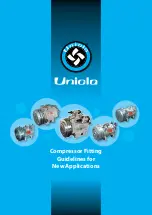
4.8 Oil Pump Inspection
If the compressor operates for a prolonged period
with dirty or contaminated crankcase oil, damage to the oil
pump and bearings may result.
1. To check the oil pump, unbolt the pump cover and
remove the oil pump, spring guide, spring and oil pump
shaft adapter as shown in figure 4.8.
2. Inspect the gears in the oil pump for corrosion or pitting
and replace if necessary.
3. Check the oil pump shaft bushing in the bearing carrier.
If the bushing is corroded, pitted or worn, the oil pump
shaft bushing should be replaced. Inspect and replace
other parts as necessary.
4. Before reassembling the oil pump mechanism, replace
the O-rings in the oil pump cover and on the oil pump
shaft adapter (see figure 4.8).
5. Rotate the drive pin in the crankshaft to a vertical
position for easiest reassembly.
6. Insert the shaft adapter so it engages the drive pin.
7. Next, insert the spring, spring guide and oil pump
assembly. The pin on the oil pump must align with the
slot in the pump shaft adapter.
8. Install the pump cover so the pin on the case is in the
opening on the oil pump assembly as shown in figure
4.8. When you are sure the pin is properly aligned, install
the cover bolts finger tight. If alignment is correct, the
pump cover will mount flush to the bearing carrier. If it
does not, re-check the pin alignment.
9. Tighten the bolts in an alternating sequence. See
section 2.3 for directions on oil pressure adjustment.
10. Finally, rotate the crankshaft by hand to ensure smooth
operation. Then rotate it in opposite directions, listening
for a click, which indicates proper alignment of the oil
pump’s pins and slots.
Chapter 5—Extended Storage
Procedures
Following a few simple procedures will greatly minimize the
risk of the unit becoming corroded and damaged. Corken
recommends the following precautions to protect the
compressor during storage:
1. Drain the crankcase oil and refill with rust inhibiting oil.
2. Operate for a few minutes while fogging oil into the
compressor suction.
3. Relieve V-belt tension.
4. Plug all openings to prevent entry of insects and
moisture. (The cylinders may also be protected by the
use of a vapor phase inhibitor, silica gel, or dry nitrogen
gas. If the silica gel is used, hang a tag on the unit
indicating that it must be removed before start-up.)
5. Store in a dry area and off the ground if possible.
6. Rotate the flywheel every two weeks if possible.
Figure 4.8: Oil pump inspection
19
















































